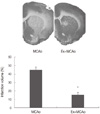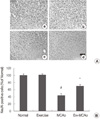Abstract
Purpose
This study was done to identify whether pre-conditioning exercise has neuroprotective effects against cerebral ischemia, through enhance brain microvascular integrity.
Methods
Adult male Sprague-Dawley rats were randomly divided into four groups: 1) Normal (n=10); 2) Exercise (n=10); 3) Middle cerebral artery occlusion (MCAo), n=10); 4) Exercise+MCAo (n=10). Both exercise groups ran on a treadmill at a speed of 15 m/min, 30 min/day for 4 weeks, then, MCAo was performed for 90 min. Brain infarction was measured by Nissl staining. Examination of the remaining neuronal cell after MCAo, and microvascular protein expression on the motor cortex, showed the expression of Neuronal Nuclei (NeuN), Vascular endothelial growth factor (VEGF) & laminin.
Results
After 48 hr of MCAo, the infarct volume was significantly reduced in the Ex+MCAo group (15.6±2.7%) compared to the MCAo group (44.9±3.8%) (p<.05), and many neuronal cells were detected in the Ex+MCAo group (70.8±3.9%) compared to the MCAo group (43.4±5.1%) (p<.05). The immunoreactivity of laminin, as a marker of microvessels and Vascular endothelial growth factor (VEGF) were intensively increased in the Ex+MCAo group compared to the MCAo group.
Figures and Tables
Figure 1
The effect of pre-conditioning exercise on the infarct volume induced by middle cerebral artery occlusion (MCAo) in the motor cortex was measured by Nissl staining. Infarct volume was reduced in Ex+MCAo group compared to MCAo group. Values are mean±SE (*p<.05 vs MCAo). MCAo=middle cerebral artery occlusion; Ex=exercise.

Figure 2
(A) Photographs of NeuN immunoreactivity in the motor cortex. There are many NeuN-positive cells in Normal (a) and Ex. group (b), compared to MCAo group (c). However, in Ex+MCAo group, (d) NeuN-positive cells were increased compared to MCAo group (scale bar, 100 µm). (B) Exercise significantly increased NeuN-positive cells in the mortor cortex. Values are mean±SE (#p<.05 vs Normal, *p<.05 vs MCAo). MCAo=middle cerebral artery occlusion; Ex=exercise; NeuN=neuronal nuclei.

Figure 3
The immunoreactivity of laminin in motor cortex. In normal (A) and Ex. group (B), micro vessels were intensively marked by laminin, and very little immunoreactivity of laminin was marked in MCAo group (C). However, in Ex+MCAo group (D), laminin expression was increas-ed compared to MCAo group (scale bar, 100 µm), MCAo=middle cerebral artery occlusion; Ex=exercise.

Figure 4
Intensively VEGF immunoreactivity was shown in MCAo group (C) In Ex+MCAo group (D), little VEGF expression was observed, however, there was no VEGF immunoreactivity in either normal (A) or Ex. group (B) (scale bar, 100 µm). MCAo=middle cerebral artery occlusion; Ex=exercise; VEGF=vas-cular endothelial growth factor.

References
1. Ang ET, Wong PT, Moochhala S, Ng YK. Neuroprotection associated with running: Is it a result of increased endogenous neurotrophic factors? Neuroscience. 2003. 118:335–345.
2. Carroll S, Dudfield M. What is the relationship between exercise and metabolic abnormalities? A review of the metabolic syndrome. Sports Medicine. 2004. 34:371–418.
3. Chrysohoou C, Pitsavos C, Kokkinos P, Panagiotakos DB, Singh SN, Stefanadis C. The role of physical activity in the prevention of stroke. Central European Journal of Public Health. 2005. 13:132–136.
4. Cobbs CS, Chen J, Greenberg DA, Graham SH. Vascular endothelial growth factor expression in transient focal cerebral ischemia in the rat. Neuroscience Letters. 1998. 249:79–82.
5. Croll SD, Weigand SJ. Vascular growth factors in cerebral ischemia. Molecular Neurobiology. 2001. 23:121–135.
6. del Zoppo GJ, Mabuchi T. Cerebral microvessel responses to focal ischemia. Journal of Cerebral Blood Flow. Journal of Cerebral Blood Flow & Metabolism. 2003. 23:879–894.
7. Ding Y, Li J, Luan X, Ding YH, Lai Q, Rafols JA, et al. Exercise pre-conditioning reduces brain damage in ischemic rats that may be associated with regional angiogenesis and cellular overexpression of neurotrophin. Neuroscience. 2004. 124:583–591.
8. Endres M, Gertz K, Lindauer U, Katchanov J, Schultze J, Schröck H, et al. Mechanisms of stroke protection by physical activity. Annals of Neurology. 2003. 54:582–590.
9. Greenlund KJ, Giles WH, Keenan NL, Croft JB, Mensah GA. Physician advice, patient actions, and health-related quality of life in secondary prevention of stroke through diet and exercise. Stroke. 2002. 33:565–571.
10. Hamann GF, Okada Y, Fitridge R, del Zoppo GJ. Microvascular basal lamina antigens disappear during cerebral ischemia and reperfusion. Stroke. 1995. 26:2120–2126.
11. Heiss WD, Sobesky J, Hesselmann V. Identifying thresholds for penumbra and irreversible tissue damage. Stroke. 2004. 35:2671–2674.
12. Kaya D, Gürsoy-Ozdemir Y, Yemisci M, Tuncer N, Aktan S, Dalkara T. VEGF protects brain against focal ischemia without increasing blood-brain permeability when administered intracerebroventricularly. Journal of Cerebral Blood Flow & Metabolism. 2005. 25:1111–1118.
13. Kim IH. The effects of exercise therapy and exercise-behavior modification therapy on obesity, blood lipids, and self-esteem of the obese middle-aged women. Journal of Korean Academy of Nursing. 2002. 32:844–854.
14. Kleim JA, Cooper NR, VandenBerg PM. Exercise induces angiogenesis but does not alter movement representations within rat motor cortex. Brain Research. 2002. 934:1–6.
15. Lee JI. Effects of walking exercise intensities on fatigue, serum lipids and immune function among middle-aged women. Journal of Korean Academy of Nursing. 2006. 36:94–102.
16. Lennmyr F, Terént A, Syvänen AC, Barbany G. Vascular endothelial growth factor gene expression in middle cerebral artery occlusion in the rat. Acta Anaesthesiologica Scandinavica. 2005. 49:488–493.
17. Li J, Ding YH, Rafols JA, Lai Q, McAllister JP II, Ding Y. Increased astrocyte proliferation in rats after running exercise. Neuroscience Letters. 2005. 386:160–164.
18. Lo EH, Moskowitz MA, Jacobs TP. Exciting, radical, suicidal: How brain cells die after stroke. Stroke. 2005. 36:189–192.
19. Shibuya M. Brain angiogenesis in developmental and pathological processes: Therapeutic aspects of vascular endothelial growth factor. Federation of European Biochemical Societies Journal. 2009. 276:4636–4643.
20. Mattson MP, Duan W, Wan R, Guo Z. Prophylactic activation of neuroprotective stress response pathways by dietary and behavioral manipulations. NeuroRx. 2004. 1(1):111–116.
21. Simard M, Arcuino G, Takano T, Liu QS, Nedergaard M. Signaling at the gliovascular interface. Journal of Neuroscience. 2003. 23:9254–9262.
22. Annual report of causes of death in Korea. Statistics Korea. 2009. August. 31. Retrieved August 31, 2009. from http://kostat.go.kr/portal/korea/kor_nw/2/6/1/index.board?bmode=read&bSeq=&aSeq=66244&pageNo=2&rowNum=10&navCount=10&currPg=&sTarget=title&sTxt.
23. Trendelenburg G, Dirnagl U. The neuroprotective role of astrocytes in cerebral ischemia: Focus on ischemic preconditioning. Glia. 2005. 50:307–320.
24. Weis SM, Cheresh DA. Pathophysiological consequences of VEGF-induced vascular permeability. Nature. 2005. 437:497–504.
25. Yurchenco PD, Schittny JC. Molecular architecture of basement membranes. The FASEB Journal. 1990. 4:1577–1590.
26. Zhang ZG, Zhang L, Jiang Q, Zhang R, Davies K, Powers C, et al. VEGF enhances angiogenesis and promotes blood-brain barrier leakage in the ischemic brain. Journal of Clinical Investigation. 2000. 106:829–838.




 PDF
PDF ePub
ePub Citation
Citation Print
Print




 XML Download
XML Download